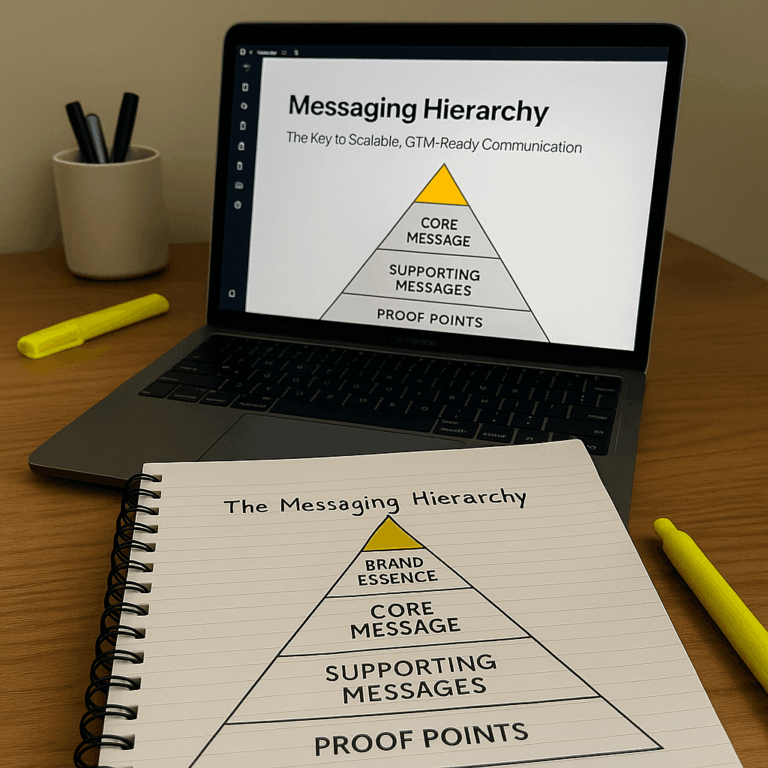Messaging Hierarchy: The Key to Scalable, GTM-Ready Communication

- 1. What Is a Messaging Hierarchy?
- 2. Why Your Brand Needs a Messaging Hierarchy
- 3. The Messaging Hierarchy Pyramid
- 4. How to Build a Messaging Hierarchy
- 5. Scaling Communication With a Messaging Hierarchy
- 6. Case Study: Data-Informed Messaging Hierarchies
- 7. The Foundation for GTM-Ready Communication
When you go to market with a new brand or product, leading with a feature list won’t win over your target audience. Even the most sophisticated strategy can fail if your marketing messages don’t connect. What resonates with potential customers is clear storytelling that shows the transformation your product or service delivers.
That’s where a messaging hierarchy comes in. By prioritizing your most compelling, on-brand statement first and layering in supporting details, you create a structured framework for communication that scales across every channel. A clear hierarchy ensures your brand voice is unified, your communication goals are met, and your message resonates with the right audience segments.
What Is a Messaging Hierarchy?
A messaging hierarchy is a brand messaging framework that organizes your narrative from the broadest brand essence down to specific proof points. It bridges market research, persona development, and customer insight into a repeatable system.
Instead of reinventing your brand message for every campaign, a robust messaging hierarchy provides a template that scales across social media, email, web content, sales conversations, and more. It anchors every piece of communication back to a single core message.
Why Your Brand Needs a Messaging Hierarchy
Building without one is like assembling furniture without instructions: you might have great parts, but the end result is fragmented. A hierarchy provides:
-
Clarity – Your target customers immediately understand what you do and why it matters.
-
Consistency – Every channel reinforces the same key message, building trust with consumers.
-
Efficiency – Marketing teams spend less time debating and more time executing.
-
Differentiation – A structured narrative highlights your unique value against competitors.
Research shows that brand communication consistency can contribute 10–20% of revenue growth — proof that alignment drives measurable results.
The Messaging Hierarchy Pyramid
Most messaging hierarchies use a pyramid model:
| Level | Purpose | Example Element |
|---|---|---|
| Brand Essence | The distilled positioning statement guiding all communication. Not a tagline, but your “north star.” | Vision or mission statement |
| Core Message | The single most important takeaway. What you do differently and why it matters. | Clear value proposition |
| Supporting Messages | Specific messages tailored for different audience segments, use cases, or competitive contexts. | Messaging pillars for B2B vs B2C groups |
| Proof Points | Evidence that validates your story — data, testimonials, certifications, or case studies. | ROI stats, customer reviews |
This message architecture ensures every marketing effort ladders back to one central truth, regardless of channel or audience segment.
How to Build a Messaging Hierarchy
-
Gather data – Use surveys, customer interviews, and persona research to understand your target customers. Identify what challenges they face and what transformation they want.
-
Define your brand – Clarify values and differentiators. Your positioning statement and mission should anchor every communication goal.
-
Develop the core message – Craft a complete value proposition. Test it internally, then validate it with target audiences for resonance.
-
Create supporting messages – Build pillars tailored to different audiences or features. Each should reinforce your overall brand identity.
-
Add proof points – Incorporate behavioral data, testimonials, marketing case studies, and performance metrics for credibility.
-
Test and refine – Apply the hierarchy across social media platforms, ads, and content. Adjust based on performance metrics and customer journey feedback.
Scaling Communication With a Messaging Hierarchy
-
Channel alignment: A homepage may present the full messaging hierarchy template, while a social media post highlights one supporting message. Both reinforce the same core message.
-
Sales + marketing integration: A shared hierarchy prevents misalignment between teams, ensuring the customer hears one consistent narrative.
-
Content creation at scale: Content creators can produce faster, more consistent work when guided by a hierarchy. This efficiency reduces confusion as organizations grow.
Case Study: Data-Informed Messaging Hierarchies
A musical instrument manufacturer struggled with fragmented communication due to outdated personas. Marketing efforts fell flat and budgets were wasted. Through an analysis of their target audience surveying of 3,500 past purchasers, fusepoint uncovered new audience groups with high conversion potential. Rebuilding the hierarchy with these insights improved acquisition efficiency and delivered stronger brand awareness.
The lesson: A clear messaging hierarchy must be built on real customer data, not assumptions.
The Foundation for GTM-Ready Communication
A messaging hierarchy is more than a marketing tool — it’s the foundation of scalable brand communication. It ensures your brand voice is consistent, your communication goals are clear, and your narrative adapts to different channels without losing its essence.
For organizations preparing to launch or scale, building a hierarchy isn’t optional — it’s essential. fusepoint provides go-to-market strategy consulting to help brands develop data-driven messaging hierarchies that align marketing and sales, sharpen positioning, and accelerate go-to-market success.
Our Editorial Standards
Reviewed for Accuracy
Every piece is fact-checked for precision.
Up-to-Date Research
We reflect the latest trends and insights.
Credible References
Backed by trusted industry sources.
Actionable & Insight-Driven
Strategic takeaways for real results.










